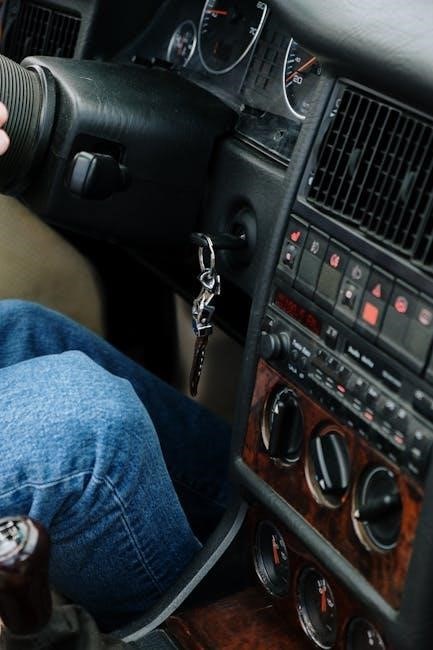Manual transmissions‚ or stick shift cars‚ require drivers to manually control gear changes using a clutch pedal and shift lever. This system provides better fuel efficiency‚ lower costs‚ and more control over the vehicle. Learning to drive a stick shift is a valuable skill that enhances driving engagement and offers a deeper connection to the car’s performance. It’s a foundational skill for any aspiring driver seeking mastery behind the wheel.
Why Learn to Drive a Stick Shift?
Learning to drive a stick shift offers numerous benefits‚ including better fuel efficiency‚ lower vehicle costs‚ and increased control over the car. It enhances driving engagement and connection to the vehicle’s performance. Mastering a manual transmission also broadens car ownership options and is often preferred for its superior handling and driving experience. Additionally‚ it reduces reliance on automatic systems‚ fostering a deeper understanding of driving mechanics. These skills are invaluable for any driver seeking greater control and confidence on the road.
Benefits of Manual Transmission Over Automatic
Manual transmissions offer several advantages over automatics‚ including improved fuel efficiency‚ lower purchase costs‚ and reduced maintenance expenses. They provide better control and a more engaging driving experience. Manuals typically have fewer mechanical complexities‚ leading to longer lifespans and lower repair bills. They also enhance driver connection to the vehicle‚ making driving more enjoyable and rewarding. These benefits make manual transmissions a preferred choice for cost-conscious and performance-oriented drivers seeking a more involved driving experience.

Preparation for Manual Driving Lessons
Prepare by finding a safe‚ open space to practice and familiarize yourself with the car’s controls‚ such as the clutch‚ gearshift‚ and pedals‚ before starting lessons.
Finding a Safe Practice Location
A large‚ empty parking lot is ideal for practicing manual driving. Look for a flat‚ open space with no obstacles or traffic. Avoid busy streets or inclines initially‚ as they can make learning more challenging. Ensure the area is safe and free from distractions. Starting in a controlled environment helps build confidence and reduces the risk of stalling or jerky movements. Once comfortable‚ you can gradually move to more complex settings‚ like quiet neighborhood streets or slight inclines.
Understanding the Basic Controls of a Manual Car
Familiarizing yourself with the basic controls is essential before starting lessons. The three main components are the clutch pedal‚ gearshift‚ and accelerator. The clutch pedal‚ located on the far left‚ disengages the engine from the transmission. The gearshift‚ mounted on the center console or floor‚ allows you to manually select gears. The accelerator‚ on the far right‚ controls engine speed. Understanding how these components work together is the first step in mastering manual driving. Proper coordination of these elements ensures smooth operation.
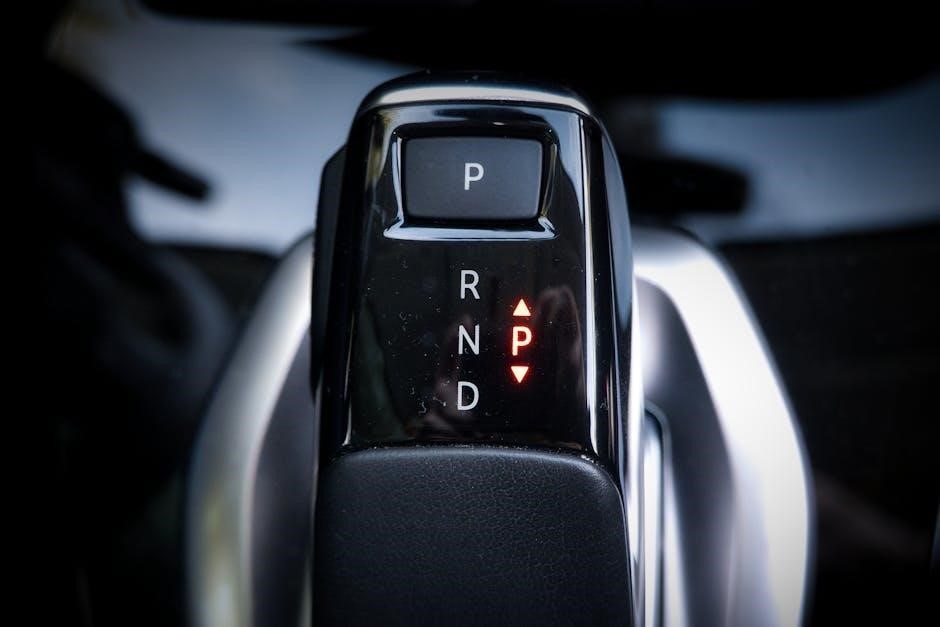
Mastering the Clutch and Gear Shifting
Mastering the clutch and gear shifting requires coordination between the clutch pedal‚ accelerator‚ and gearshift. Smooth transitions depend on listening to engine cues and using the clutch pedal gradually.
How the Clutch Works
The clutch is a vital component in manual transmissions‚ connecting and disconnecting the engine from the gearbox. When pressed‚ it disengages engine power‚ allowing smooth gear shifts. Releasing the clutch pedal gradually reconnects the engine‚ enabling the car to move. Proper clutch control is essential for smooth acceleration and preventing jerky starts. The clutch’s operation relies on the driver’s ability to balance its release with accelerator input‚ ensuring seamless power delivery and gear transitions. Mastering this balance is key to effective manual driving.
Step-by-Step Guide to Shifting Gears
Shifting gears in a manual car involves coordination between the clutch‚ gearshift‚ and accelerator. Step 1: Fully press the clutch pedal to disengage the engine. Step 2: Use the gearshift to select the desired gear‚ ensuring it clicks into place. Step 3: Slowly release the clutch while pressing the accelerator‚ feeling for the “biting point” where the engine connects with the wheels. Practice this sequence to achieve smooth transitions between gears‚ starting with first gear and progressing to higher gears as speed increases. Consistency and patience are key to mastering this process.
Practicing Clutch Control
Mastering the clutch is essential for smooth manual driving. Practice releasing the clutch slowly while pressing the accelerator to find the “biting point” where the engine engages.
Getting Familiar with the Clutch Pedal
Start by practicing the clutch pedal without starting the engine. Press it fully and slowly release to feel its resistance. The “biting point” is where the engine begins to engage. This sensation is key to smooth starts. Practice this repeatedly to build muscle memory. Keep the car in neutral while focusing on the pedal’s movement. Consistency is crucial for mastering clutch control. Begin in a flat‚ open space to minimize distractions and avoid stalling during practice sessions.
Learning to Start and Stop Smoothly
Mastering smooth starts and stops is essential for manual driving. Begin by pressing the clutch fully down and shifting into first gear. Slowly release the clutch while gently pressing the accelerator to avoid jerking. For stopping‚ downshift to lower gears as you decelerate‚ then press the clutch and brake together to come to a smooth halt. Practice in a flat‚ open area to build muscle memory and coordination between clutch and accelerator movements. Consistency and patience will help refine your technique.
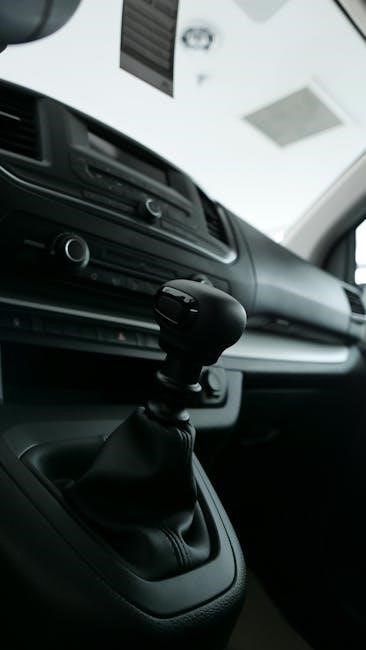
Driving Techniques
Mastering driving techniques for manual transmissions requires coordination between clutch and accelerator. Practice smooth gear shifting‚ clutch control‚ and acceleration. Start in flat areas‚ progress to inclines‚ and refine your skills in various conditions for confident driving.
Starting on an Incline
Starting on an incline requires precise clutch and accelerator coordination to prevent rolling back. Engage the handbrake‚ shift into first gear‚ and slowly release the clutch while pressing the gas. As the clutch engages‚ release the handbrake and gradually accelerate. If the car stalls‚ remain calm‚ restart‚ and try again. Practice on gentle slopes first to build confidence and smooth acceleration control. This skill is crucial for managing uphill starts effectively and safely in manual transmission vehicles.
Shifting Gears While Accelerating and Decelerating
Shifting gears smoothly during acceleration and deceleration is key to mastering manual driving. When accelerating‚ press the clutch‚ shift into the next gear‚ and release slowly while pressing the accelerator. For deceleration‚ downshift before braking to maintain control and reduce wear on the brakes. Use the engine’s sound and feel to guide your shifts‚ ensuring a seamless transition between gears. Proper timing prevents jerky movements and enhances overall driving efficiency and safety.
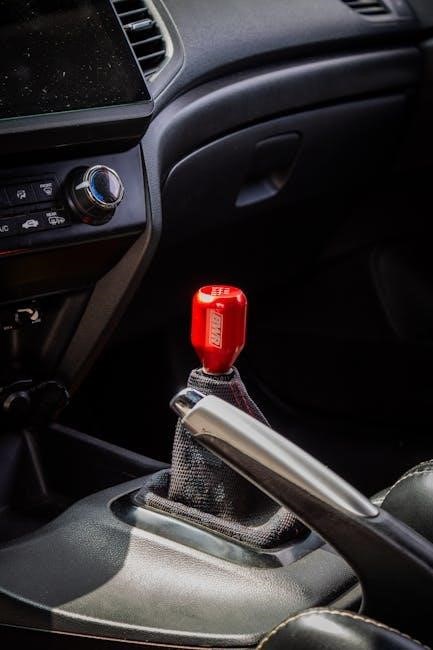
Common Challenges and Solutions
Common challenges include stalling‚ jerky movements‚ and difficulty shifting gears. Solutions involve consistent practice‚ focusing on slow clutch releases‚ and mastering the rhythm of gear transitions smoothly.
How to Avoid Stalling the Car
To avoid stalling‚ focus on slow and gradual clutch release while gently pressing the accelerator. Practice in a safe‚ flat area to build muscle memory. Start with the car off‚ releasing the clutch slowly to feel the “biting point.” When moving‚ coordinate clutch release with accelerator input to maintain momentum. Avoid sudden movements and listen to engine RPMs to anticipate when to shift gears. Consistent practice helps develop the necessary coordination and reflexes to prevent stalling.
Fixing Jerky Starts and Stops
Jerky starts and stops often result from abrupt clutch release or mismatched accelerator input. To smooth this‚ practice slow‚ gradual clutch release while simultaneously pressing the accelerator; Start in a flat‚ open area to develop a feel for the clutch’s engagement point. Balancing clutch release with gentle accelerator pressure is key. For stops‚ downshift before coming to a halt and ease off the accelerator gradually. Pausing briefly in neutral before stopping can also help. Consistent practice will refine your technique‚ leading to smoother transitions.
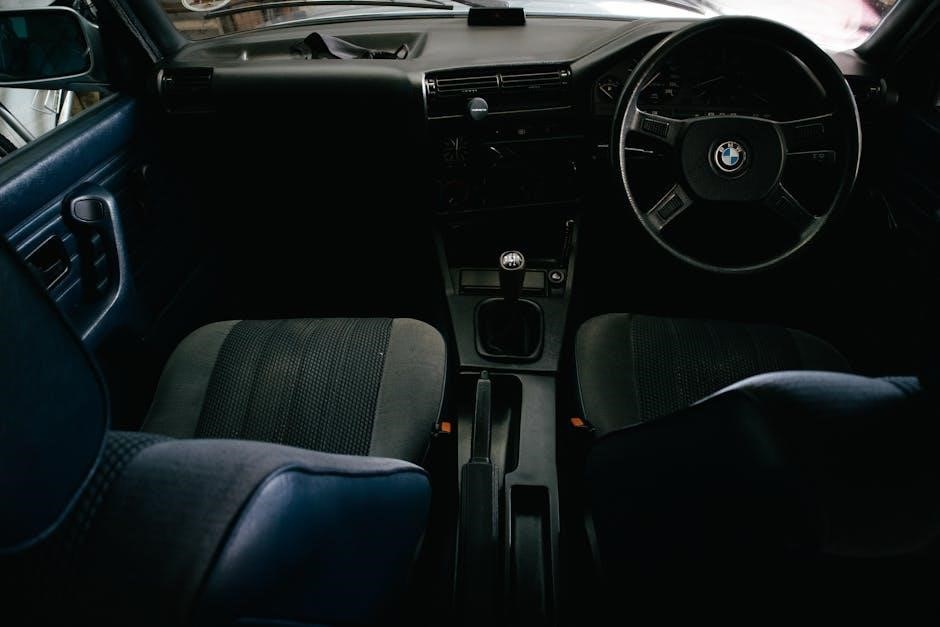
Advanced Driving Tips
Mastering techniques like heel-to-toe shifting and rev-matching enhances control and precision. These advanced methods ensure smoother transitions and better performance‚ especially on challenging roads or tracks.
Mastering Heel-to-Toe Shifting
Heel-to-toe shifting is an advanced technique where the driver uses the heel of their foot to blip the throttle while braking‚ matching engine RPM to the gear. This smooths deceleration and prevents wheel lockup. Practice by rolling into a turn‚ braking‚ and downshifting in one fluid motion. Start slowly‚ focusing on timing and pedal coordination. Mastery requires patience and consistent practice to achieve seamless transitions and improved control during cornering or downhill driving.
Understanding Rev-Matching
Rev-matching is a technique used to smooth gear changes by matching engine RPM to the target gear’s speed. It involves blipping the throttle while downshifting to align RPMs‚ reducing wear on the drivetrain. This method is especially useful during deceleration‚ as it helps maintain control and prevents abrupt shifts. Practice rev-matching in low-speed situations‚ focusing on listening to engine cues and coordinating clutch and throttle inputs. Mastery enhances smoothness and reduces mechanical stress‚ making it a valuable skill for manual drivers.
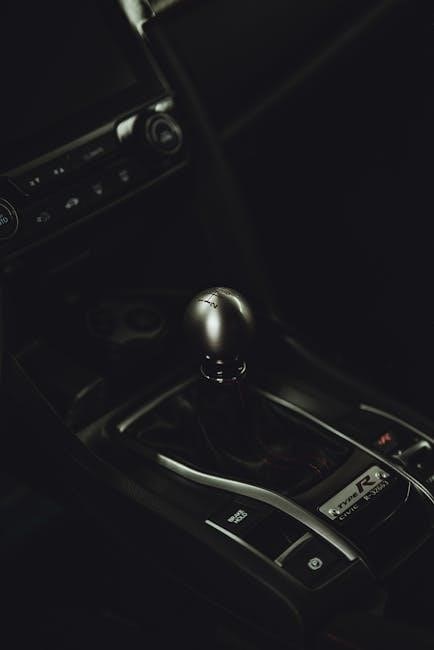
Safety and Etiquette
Mastering manual driving includes smooth acceleration‚ using mirrors‚ and signaling. Be patient with others‚ avoid sudden moves‚ and maintain a safe distance. Courtesy enhances road harmony.
Driving a Manual Car in Heavy Traffic
Driving a manual car in heavy traffic requires smooth clutch operation and careful gear shifts. Use low gears to maintain control at slow speeds. Avoid sudden acceleration and keep a safe distance. Practice shifting gears seamlessly to prevent jerking. Stay attentive to traffic flow and use mirrors to anticipate stops. Smooth clutch release and gradual acceleration help in stop-and-go situations. Listening to engine RPMs ensures you don’t stall in traffic. Patience and focus are key to navigating congestion safely and efficiently.
Manual Transmission Driving on Hills
Driving a manual car on hills requires careful clutch and gear management. Always use the brake and clutch together when starting on an incline to prevent rolling. Shift to a lower gear before descending to control speed and avoid overheating brakes. When ascending‚ maintain steady acceleration and avoid riding the clutch. Use the correct gear for the slope to prevent stalling. Stay alert and adjust gears smoothly to maintain control and ensure safe navigation of uphill and downhill terrains.
Mastering a manual transmission requires patience and consistent practice. Start in a safe environment‚ focus on smooth clutch engagement‚ and gradually build confidence. Keep at it—every stalled start brings you closer to mastery. Embrace the learning curve‚ and soon you’ll enjoy the control and satisfaction of driving a stick shift like a pro!
Key Takeaways for Successful Manual Driving
Mastering manual driving involves coordination between clutch pedal‚ gear shifts‚ and acceleration. Start in a safe‚ flat area to practice clutch control and smooth starts. Gradually incorporate uphill and downhill practices to refine your skills. Pay attention to engine sounds and vehicle responses to avoid stalling. Consistent practice is crucial‚ as muscle memory develops over time. Stay patient and persistent‚ and you’ll soon navigate any road with confidence.
Encouragement for Consistent Practice
Consistent practice is essential to mastering manual driving. Celebrate small victories‚ like smooth starts or flawless shifts‚ to stay motivated. Even if progress feels slow‚ remember that each session builds muscle memory and confidence. Don’t be discouraged by stalling or jerky movements—these are part of the learning process. Practice in a safe‚ quiet area‚ focusing on smooth transitions between clutch and throttle. With patience and persistence‚ you’ll become a skilled manual driver‚ ready to tackle any road with ease and enjoyment.
